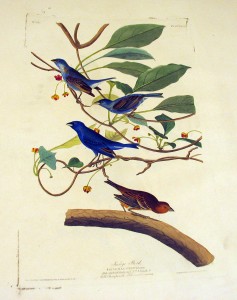 “The Indigo Bird arrives in the Southern States from the direction of Mexico, along with its relative the Painted Finch, and is caught in trap-cages, but with more difficulty than the latter bird. It spreads far and wide over the United States, extending from the borders of our Atlantic shores to those of our great lakes. It is not a forest bird, but prefers the skirts of the woods, the little detached thickets in and along the fields, the meadows, the gardens, and orchards, and is frequently seen hopping along, or perched on a fence, from which is does not disdain to send forth its pretty little song . . .
“The Indigo Bird arrives in the Southern States from the direction of Mexico, along with its relative the Painted Finch, and is caught in trap-cages, but with more difficulty than the latter bird. It spreads far and wide over the United States, extending from the borders of our Atlantic shores to those of our great lakes. It is not a forest bird, but prefers the skirts of the woods, the little detached thickets in and along the fields, the meadows, the gardens, and orchards, and is frequently seen hopping along, or perched on a fence, from which is does not disdain to send forth its pretty little song . . .
I have represented an adult female, two young males of the first and second year, in autumn, and a male in the full beauty of its plumage. They are placed on a plant usually called the Wild Sarsparilla.”
–J. J. Audubon, Ornithological Biography, I (1831), 377-379 [excerpted].